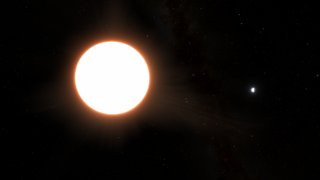
An illustration of an extremely bright, white planet orbiting its star at breakneck speed
(Image credit: Ricardo Ramírez Reyes (Universidad de Chile))
A bizarre exoplanet with metallic clouds that rain titanium onto its scalding-hot interior is the shiniest planet ever discovered, a new study shows. The Neptune-size world, which scientists say “shouldn’t exist,” acts like a giant mirror, reflecting light back toward its home star, which is positioned unusually close to the lustrous world.
The exoplanet, named LTT9779 b, was discovered in 2020 by researchers operating NASA’s Transiting Exoplanet Survey Satellite (TESS) spacecraft. The gas giant, which is around 260 light-years from Earth, is around five times more massive than our planet and orbits its sun-like star every 19 hours. Only 1 in 200 sun-like star systems contains an exoplanet with an orbit that lasts less than one day on Earth; these worlds are known as ultrashort-period planets.
In a new study published July 10 in the journal Astronomy and Astrophysics, researchers took a closer look at LTT9779 b using the European Space Agency’s Characterising Exoplanet Satellite (Cheops) spacecraft. The team found that the planet’s sun-facing side reflects around 80% of the starlight that hits it, which is the highest albedo, or reflectiveness, of a planet ever observed.
For context, Earth only reflects around 30% of the sunlight that hits our planet, despite being mainly covered by water and having highly reflective polar caps.
Related: Distant ‘hell planet’ with diamond core is the victim of a gravitational catastrophe
The secret to LTT9779 b’s high albedo is its metallic clouds, which researchers believe are made predominantly from silicate — or glass — and titanate, a salt containing titanium. When researchers first discovered the exoplanet, they assumed that its close proximity to its star would prevent cloud formation because it was too hot for these materials to condense into a cloud; the planet’s atmosphere likely reaches sweltering temperatures in excess of 3,600 degrees Fahrenheit (2,000 degrees Celsius).
But the planet’s atmosphere likely has such a high abundance of silicate and titanate gases that they can turn into liquids, similar to how water vapor can form mini-clouds in a bathroom if you leave the shower running for long enough, the study’s researchers wrote in a statement.
LTT9779 b’s metallic clouds also explain one of the exoplanet’s puzzling traits — its size. Until now, all known ultrashort-period planets are either gas giants that are much larger than Jupiter or rocky planets no larger than Earth. As a result, experts had predicted that smaller gas giants like LTT9779 b could not exist so close to their home star.
“It’s a planet that shouldn’t exist,” study co-author Vivien Parmentier, an astrophysicist at the University of Oxford in the U.K. and the Côte d’Azur Observatory in France, said in the statement. “We expect planets like this to have their atmosphere blown away by their star, leaving behind bare rock.”
However, the exoplanet’s metallic clouds can help explain its unusual size.
“The clouds reflect light and stop the planet from getting too hot and evaporating,” study lead author Sergio Hoyer, a planetary scientist at the Marseille Laboratory of Astrophysics in France and a Cheops mission scientist, said in the statement. “Meanwhile, being highly metallic makes the planet and its atmosphere heavy and harder to blow away.”
But even with its shiny shielding,LTT9779 b was most likely larger than Jupiter when it first formed and has since been eroded over time, the researchers theorize.
Until now, the shiniest known planet in the universe was Venus, which bounces back 75% of the sun’s light thanks to its highly reflective cloud layer. It was once thought that Venus’ clouds contained phosphine, a gas produced by microorganisms on Earth, which hinted that the planet may harbor extraterrestrial life. But this controversial idea about Venus’ habitability was debunked by a 2022 study.
Due to LTT9779 b’s extreme temperatures and boiling metallic rain, it also seems unlikely that the mirror-like world could support alien life.
Stay up to date on the latest science news by signing up for our Essentials newsletter.
Harry is a U.K.-based staff writer at Live Science. He studied Marine Biology at the University of Exeter (Penryn campus) and after graduating started his own blog site “Marine Madness,” which he continues to run with other ocean enthusiasts. He is also interested in evolution, climate change, robots, space exploration, environmental conservation and anything that’s been fossilized. When not at work he can be found watching sci-fi films, playing old Pokemon games or running (probably slower than he’d like).
>>> Read full article>>>
Copyright for syndicated content belongs to the linked Source : Live Science – https://www.livescience.com/space/exoplanets/mirror-like-exoplanet-that-shouldnt-exist-is-the-shiniest-world-ever-discovered































